Recognition of Learning TOC
Key Highlights of this Brief
The American Association of Collegiate Registrars and Admissions Officers (AACRAO) surveyed member institutions to better understand institutional policies and practices related to prior learning assessment (PLA).
- Eight out of 10 U.S. institutions offer one or more PLA options to students.
- Of those, more than one-third have increased their PLA offerings in the last three years.
- More than half charge a fee for one or more types of PLA, and few offer financial aid to offset the fee.
- A majority will not accept PLA in transfer.
- The more selective an institution is, the less likely it is to offer PLA; small and rural-distant institutions are also less likely to offer PLA.
- Less than one-third of institutions track PLA data over time, and it is rarely tracked at the student level (making it difficult to identify any potential equity issues).
- About one-third of survey respondents agree that there are institutional policies and/or practices that make it difficult for some students to have their prior learning recognized.
AACRAO also fielded a student survey to understand student perspectives on PLA. Noteworthy results include:
- Students’ experiences with PLA at their campuses demonstrate that there are many pathways for earning credit for college-level learning acquired through work or life experiences and that most who try are successful in doing so.
- A quarter who earned PLA credit indicated that PLA credit “made it possible for them to complete a degree/program they otherwise would not have.”
- Students also save time and money when they are given credit for prior learning.
Introduction
The American Association of Collegiate Registrars and Admissions Officers (AACRAO) has a longstanding interest in (a) understanding if and how institutions evaluate and award academic credit for prior learning and (b) using that understanding to serve as a professional development resource to help individuals and institutions adopt leading practices and policies for prior learning assessment (PLA) that are driven by student success. Registrars oversee the practice of how credits are recorded in the academic record and how these credits apply toward educational credentials. Registrars are also often at the forefront of helping to shape institutional policies related to PLA.
The effective application and understanding of PLA is one of AACRAO’s stated core professional proficiencies for academic records professionals.[1] This proficiency has been defined by AACRAO to include the following knowledge, skills, and ethical professional requirements:
- Content knowledge requirements: Knowledge of institutional catalog and degree pathways; knowledge of national best practices on the assessment of prior learning; knowledge and understanding of the Joint Statement on Transfer Credit, the AACRAO Transfer Student Bill of Rights, the AACRAO Institutional Bill of Rights and Responsibilities, AACRAO’s Guide to Best Practices: Awarding Transfer and Prior Learning Credit, the American Council on Education (ACE) National Guide, the ACE Military Guide, and common sources of credit for prior learning (CPL) including College-Level Examination Program (CLEP), Advanced Placement (AP), and International Baccalaureate (IB); familiarity with the Council for Adult and Experiential Learning (CAEL) and other national CPL organizations; and experience with academic programs, degree and general education requirements, course articulation, and degree audit systems.
- Skill requirements: Excellent skills in research, critical thinking, and analysis; attention to detail and documentation; deep understanding of curriculum and program outcomes; ability to exercise judgment and find solutions to complex problems; strong communication and project management skills; technical facility to work in degree audit and curricular management systems; and ability to develop and maintain effective collaborative working relationships with others.
- Ethical requirements: Commitment to consistency, equity, and fairness in application of policies to serve the best interests of the student, and current knowledge of PLA best practices and organizations.
AACRAO’s membership also maintains an ongoing interest in understanding PLA practices and policies because the registrar’s office (or institutional equivalent) on a campus is typically the unit in charge of enforcing policy, awarding credit, and recording credit on a student’s official transcript. The transcript is the official source of record for course and credit content used by other units in the institution, such as financial aid and advising, and as such, it is imperative that those responsible for its content are engaged in PLA at the institution.
As a result of this ongoing interest in PLA, in 2019 AACRAO partnered with the Western Interstate Commission for Higher Education (WICHE) to undertake research to better understand the current landscape around PLA within the registrar’s purview and from the student perspective. This report highlights the findings from both initiatives.
Types of Prior Learning Assessment
Many students – as well as potential students – have acquired a great deal of college-level knowledge and skills through their day-to-day lives outside of academia: from work experience, on-the-job training, formal corporate training, military training, volunteer work, self-study, and myriad other extra-institutional learning opportunities available through low-cost or no-cost online sources.
The process for recognizing and awarding credit for college-level learning acquired outside of the classroom is often referred to as Prior Learning Assessment (PLA). There are several ways students can demonstrate this learning and earn credit for it in college. The various partners involved in creating this series of briefs are examining different types of PLA and using the following general descriptions of the different methods.
- Standardized examination: Students can earn credit by successfully completing exams such as Advanced Placement (AP), College-Level Examination Program (CLEP), International Baccalaureate (IB), Excelsior exams (UExcel), DANTES Subject Standardized Tests (DSST), and others.
- Faculty-developed challenge exam: Students can earn credit for a specific course by taking a comprehensive examination developed by campus faculty.
- Portfolio-based and other individualized assessment: Students can earn credit by preparing a portfolio and/or demonstration of their learning from a variety of experiences and non-credit activities. Faculty then evaluate the student’s portfolio and award credit as appropriate.
- Evaluation of non-college programs: Students can earn credit based on recommendations provided by the National College Credit Recommendation Service (NCCRS) and the American Council on Education (ACE) that conduct evaluations of training offered by employers or the military. Institutions also conduct their own review of programs, including coordinating with workforce development agencies and other training providers to develop crosswalks that map between external training/credentials and existing degree programs.
Background
Earlier AACRAO PLA Research
AACRAO regularly surveys its members on institutional PLA practices and policies with iterations held in 2014, 2015, and 2017. The 2019 survey was the first to be conducted in conjunction with WICHE, but in all instances, CAEL content was used to help shape the content of the survey.
AACRAO’s December 2014 60-Second Survey focused on PLA options associated with adult learners.[3] This survey was designed to capture a snapshot of PLA practices (excluding AP and IB credit) in under a minute and resulted in responses primarily (94 percent) from institutions in the United States. Of the 966 institutions that responded to the survey, 83 percent indicated that they accept PLA in one format or another.
In 2015, registrars at U.S. institutions were queried on PLA practices as part of a larger survey on academic record and transcript practices. The results of this survey were published as a standalone report and used to help develop practice recommendations for the AACRAO 2016 Academic Record and Transcript Guide.[4] In this survey, 88 percent of institutions reported awarding credit for prior learning. As a result, AACRAO formed the recommendation that PLA credits should be recorded as transfer credit with an informative identifier in the student’s academic record, regardless of the way in which the PLA was earned. The AACRAO 2020 Academic Record and Transcript Guide maintains the same practice recommendation.
Finally, in May 2017, AACRAO members were sent a 60-Second Survey on transfer credit policy, including one question about PLA.[5] Less than half of respondents reported that their institution’s transfer policy explicitly addresses how PLA is treated in transfer.
AACRAO PLA Research and Recommendations
In 2019, AACRAO member institutions in the U.S. that serve undergraduate students were invited to complete a comprehensive survey containing both fixed responses and open-ended questions. The survey was intended to capture both descriptive data on institutional PLA practices and policies, as well as the opinion of the respondent on equity, access, and whether or not data are used to understand PLA’s impact on student success. It contained two branches: one for institutions that use PLA and one for those that do not.[6] In addition to the undergraduate-serving institutions, over 1,000 current college students were surveyed on their experiences with PLA. Their responses are included in this report, starting on page 11 . For more detailed analysis of the student data, see the brief written by WICHE, PLA from the Student’s Perspective: Lessons Learned from Survey and Interview Data.
2019 Research Questions
- What are the current institutional policies and practices for two- and four-year institutions around tracking PLA credits on student transcripts and in institution information systems?
- Are there any issues of equity associated with the application and availability of PLA across the student populations served?
- How are data used to understand the institutional challenges and successes in the use of PLA, if at all?
- What level of familiarity do students have with earning credit for college-level learning acquired through work or life experiences?
- What experiences are students using to try and obtain PLA credit and what level of success do they have in earning credit?
- Are there differences in the percentage of students who earn PLA credit based on demographic characteristics or type of institution attended?
- How, if at all, has credit earned through PLA impacted students’ post-secondary experience?
Findings
Institutional Results
Over 400 (n=458) U.S. undergraduate, degree-granting institutions participated in the survey. This sample population was compared to the overall population of institutions on several variables, summarized below and provided in detail in Appendix A. These comparisons help frame the generalizability of the survey data across institutional characteristics.
- Four-year institutions are more heavily represented compared to their share of higher education institutions overall (74 percent and 66 percent, respectively) and two-year institutions are somewhat underrepresented among respondents (26 percent compared to 33 percent overall).
- Public institutions are more heavily represented (50 percent in sample and 30 percent overall).
- Midwestern institutions participated at a higher rate than institutions from other regions; the West was the most underrepresented.
- The sample reflects the overall prevalence of minority-serving institutions but does not fully reflect underrepresented student attendance patterns (e.g., distribution throughout the country or across level of institutions).
- Open-access and less selective institutions are underrepresented.
In the context of this brief, the term “statistically” means there is a statistically significant difference from the mean as measured by a Chi-Squared test unless otherwise stated. If the term statistically is not used to describe a difference, then the value is different descriptively but not statistically.
Summary of Key Findings
- 79 percent of surveyed institutions in the U.S. offer one or more PLA option to students.
- Standardized exams are recognized by 93 percent of these institutions.
- Institutions in rural areas are statistically less likely than other locales to offer PLA.[7]
- Institutions with an enrollment under 1,000 are statistically less likely than other locales to offer PLA.
- The more selective an institution is, the less likely it is to offer PLA.
- 71 percent of institutions offer PLA at the bachelor’s level, and 67 percent offer it at the associate level.
- Reasons for offering PLA options include:
- to attract students
- to assist students in getting the credit they deserve
- to improve degree completion/student success
- to reduce students’ costs and time to degree
- 38 percent of institutions have increased their PLA offerings in the last three years.
- 60 percent charge a fee for one or more types of PLA, and few offer financial aid to offset the fee.
- 65 percent will not accept PLA in transfer (evaluated by another institution).
- Institutional culture and a perceived lack of academic rigor in PLA options are among the reasons listed by non-PLA institutions as reasons for not offering PLA.
- Less than one-third of institutions that offer PLA track PLA data over time.
- Even fewer institutions collect and analyze student demographic level data related to PLA and, as such, few understand how students are either well served or underserved. This makes it difficult to identify any issues with inequities.
- About one-third agree that there are institutional policies and/or practices that make it more difficult for some students to have their prior learning recognized.
- Reasons for offering PLA options include:
Institutions with PLA Practice and Policy
Nearly 8 in 10 institutions offer one or more types of PLA. Although the effect size is small,[8] it is also statistically more likely for public and/or lower-division-only institutions to offer PLA. The self-reported institutional reasons for offering PLA can be distilled to four themes, in no particular order: 1) attracting students, 2) assisting students with getting the credit they deserve, 3) improving degree completion/student success, and 4) reducing student costs and time to degree.
PLA Credential Level, Category, and Applicability
The majority of institutions allow PLA to be applied to more than one type of educational credential (see Figures 1 and 2). Many of the institutions report accepting multiple categories of PLA. Standardized exams are the most commonly accepted method of PLA. Appendix B contains the types of assessments in use within each of the PLA categories listed in Figure 2.

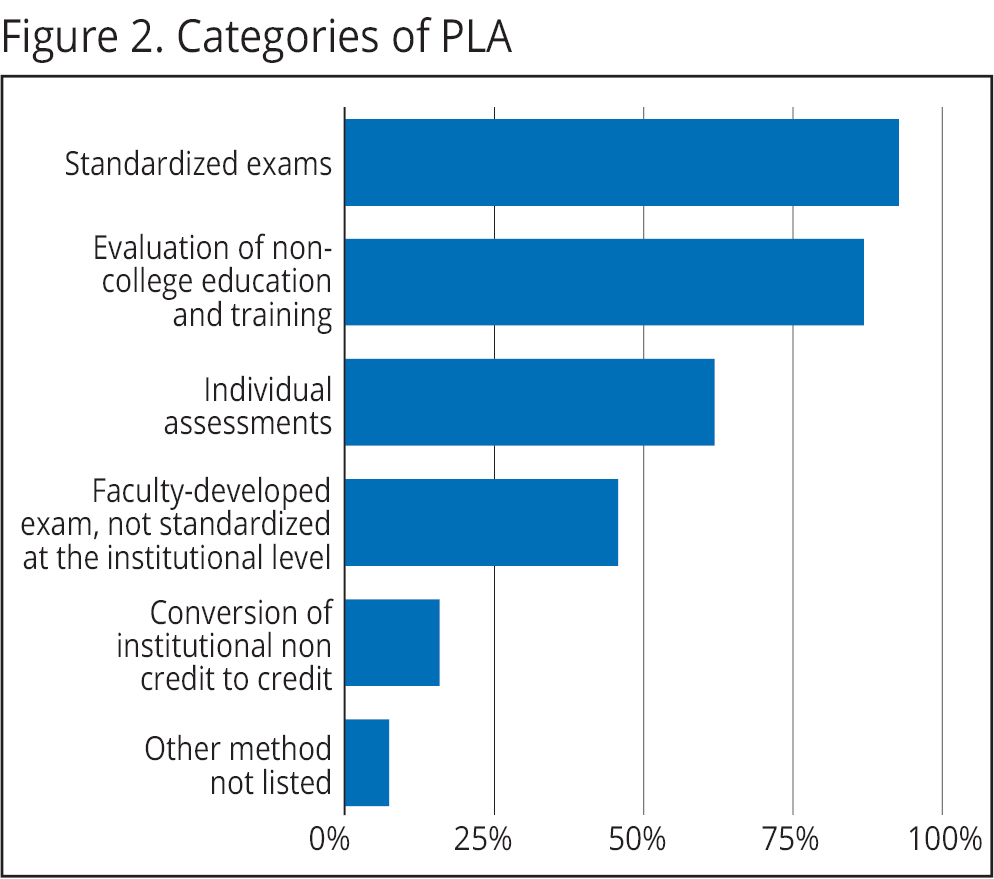
For those institutions with three or more years of experience with PLA, 61 percent have not changed their PLA offerings in the last three years, 38 percent have increased them, and one institution has reduced its use of PLA. The one institution that reduced its PLA offerings did so because it discontinued its partnership with CAEL’s Learning Counts program. For the 38 percent of institutions that have increased their PLA offerings, reasons stated include an institutional-level or state-level effort to do so, increased awareness of PLA among students, and changes to policies and procedures that have made it easier to earn PLA. At the institutions where there has been no change in PLA in the last three years, slightly more than half indicated that the institution as a whole is not satisfied with that trend and would like to see more PLA awarded.
Several themes emerged from the open-ended responses to the question, “Why were the methods expanded?” These themes included an expansion of military credit acceptance, changes to how AP and IB credits are accepted, state or institutional-level initiatives aimed at intentionally increasing options to increase completion and remove barriers, an attempt to attract more students, and an increasing request for PLA from students, especially adult students. The reasons for increasing PLA offerings are summarized well by this anonymized quote:
We have to recognize the fact that individuals learn outside of the classroom and we are looking for a way to match what we are required to do for accreditation and what we think meets the same student learning outcomes for the program or the courses.
In addition to the methods listed in Figure 2, other methods used to award PLA include:
- Documented work experience
- Special faculty or academic administrator approval
- Memoranda of understanding (MOUs) with employers
- Saylor Academy
- StraighterLine
- Oral exam
Institutions reported that PLA can be applied across a broad spectrum of requirements, and the practice varies little by institutional type (see Figure 3 and Table 1).
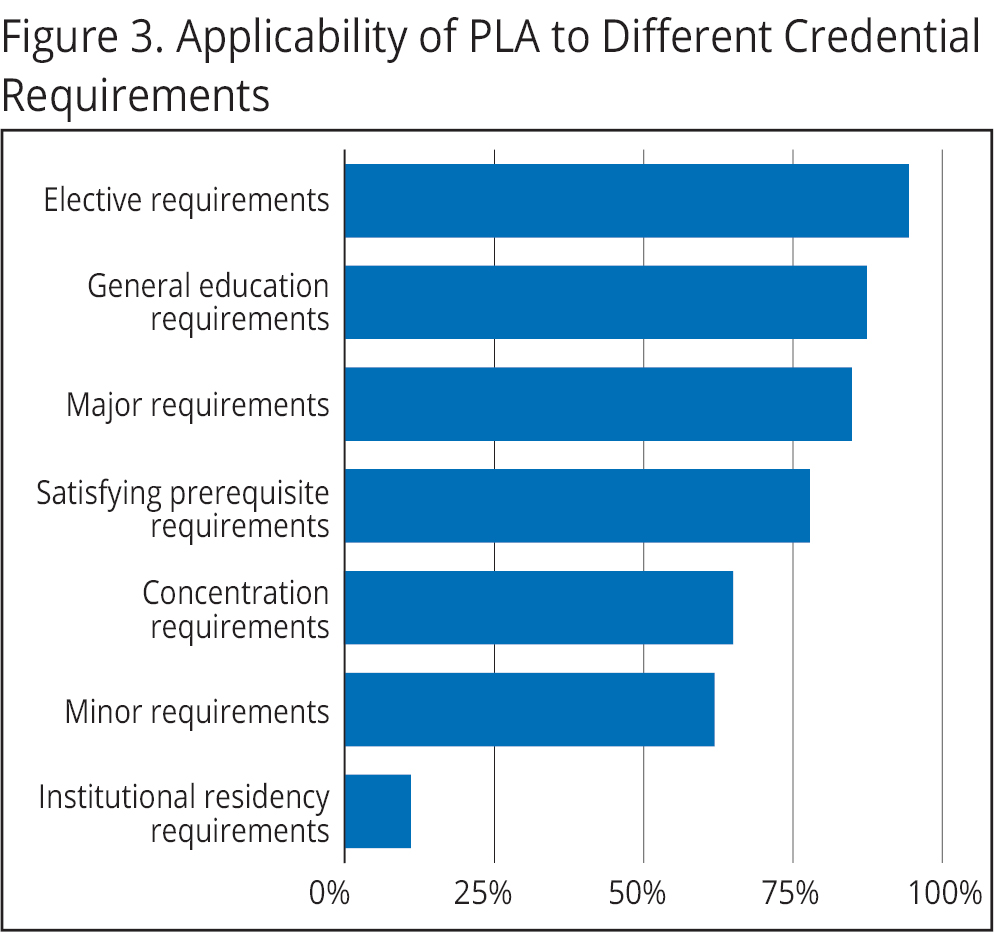
Fees
More than one-half of institutions (60 percent) charge a fee for one or more categories of PLA, and public and/or lower-division-only institutions are statistically more likely to do so.[9] The survey prompted those that charge a fee to select the type of fee for each PLA category, from the following choices: 1) a standardized fee based on credit hours awarded to the transcript, 2) a standardized fee based on the services performed in the assessment of PLA, 3) variable fees based on a number of factors, or 4) no fee for this type of PLA (see Table 2). It is more common for institutions to charge for standardized exams, individual assessments, and faculty developed exams. More than half of institutions do not charge a fee for the evaluation of non-college education and training, the conversion of institutional noncredit to credit, and the other PLA methods not listed in the survey response choices. Most institutions do not offer financial aid to help offset the PLA fees (see Table 3).


Student Awareness
Part of the institution’s PLA sphere of practice is making students aware of PLA opportunities. Academic advisors and the college catalog are the two most common methods of informing students of PLA opportunities, and orientation is the least likely source of information (see Figure 4).[10]
Transcript and Academic Record Practices
How credit for PLA is recorded and annotated in a student’s academic record may impact how that credit is applied toward credential requirements, whether it impacts the grade point average, whether it counts as residential credit (credit earned at a student’s home campus) or transfer credit (credit earned elsewhere), and in some instances whether or not a fee is charged for the credit. The survey contained several questions about how the different PLA options are transcripted, including:
- whether or not PLA is transcripted,
- whether PLA is recognized as transfer or residential credit,
- grading and GPA inclusion, and
- block or course equivalency credit.
For most categories of PLA, the credit is recorded as transfer credit on a student’s transcript, with the exception of faculty-developed exams, for which credit is more likely to be awarded as residential credit (see Table 4). Some institutions award PLA credit but do not record it on a student’s transcript. It is unclear from this data how these institutions keep track of and apply this credit towards a student’s degree since it is not recorded on the transcript.

Many institutions will not accept transfer credit recorded on another institution’s transcript if it is clearly differentiated from residential credit. Thus, it is more advantageous to students who intend to transfer for institutions to record PLA credit as residential credit.
Respondents were asked to provide further details about how individualized learning assessments credit was documented. Most responded that they assign course equivalency credit (see Table 5).

Less than 5 percent of institutions report that they assign a grade for PLA credit and include it in the GPA calculation. Rather, institutions indicated that they either assign a grade but do not include it in the GPA or do not assign a grade at all (see Table 6).

In practice, there are often differences between the content of the PLA data stored in the Student Information System (SIS) and the data recorded on the transcript; that is, some of the PLA data can reside in the SIS but not be recorded on the transcript. The survey contained questions aimed at capturing these nuances. It is apparent from the data that SIS and transcript practices vary considerably among institutions (see Tables 7 and 8). Only one-quarter of respondents reported linking the PLA data back to student demographic data; and no one type, size, or control of institution is more or less likely to do so.

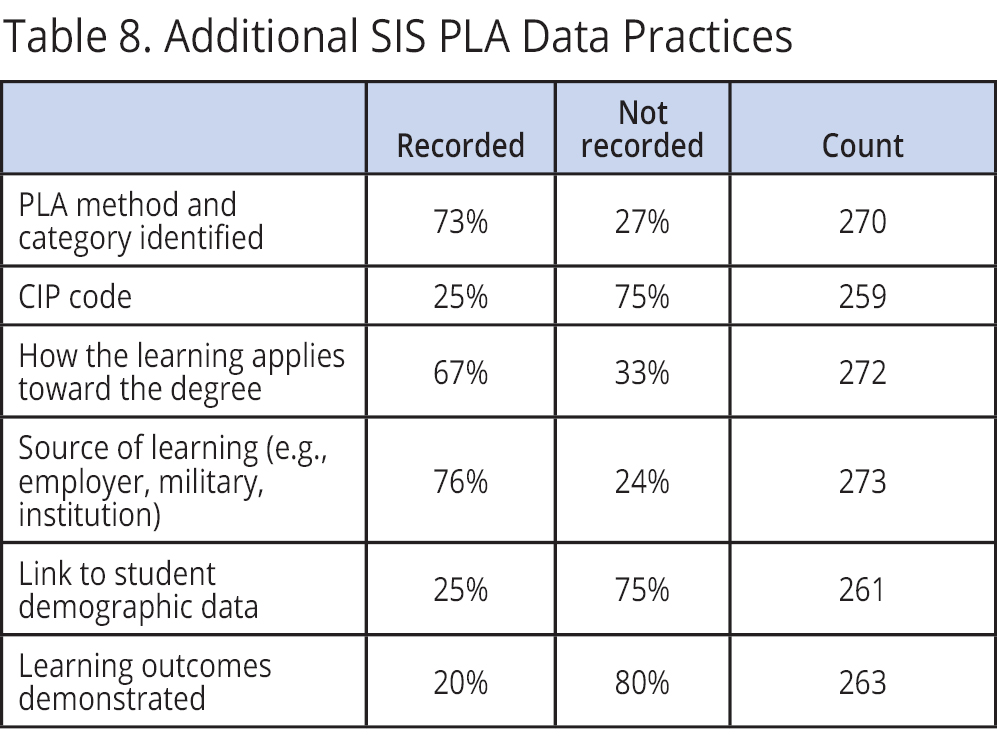
Technology and Staffing
Several questions in the survey targeted technology used to support PLA and staffing levels associated with PLA. The type and breadth of technology used to support PLA affects the ability to measure the impact of PLA on student success. Almost all respondents reported using the SIS to support PLA, but less than one-quarter use other technology, such as a reporting system or data warehouse (see Figure 5).
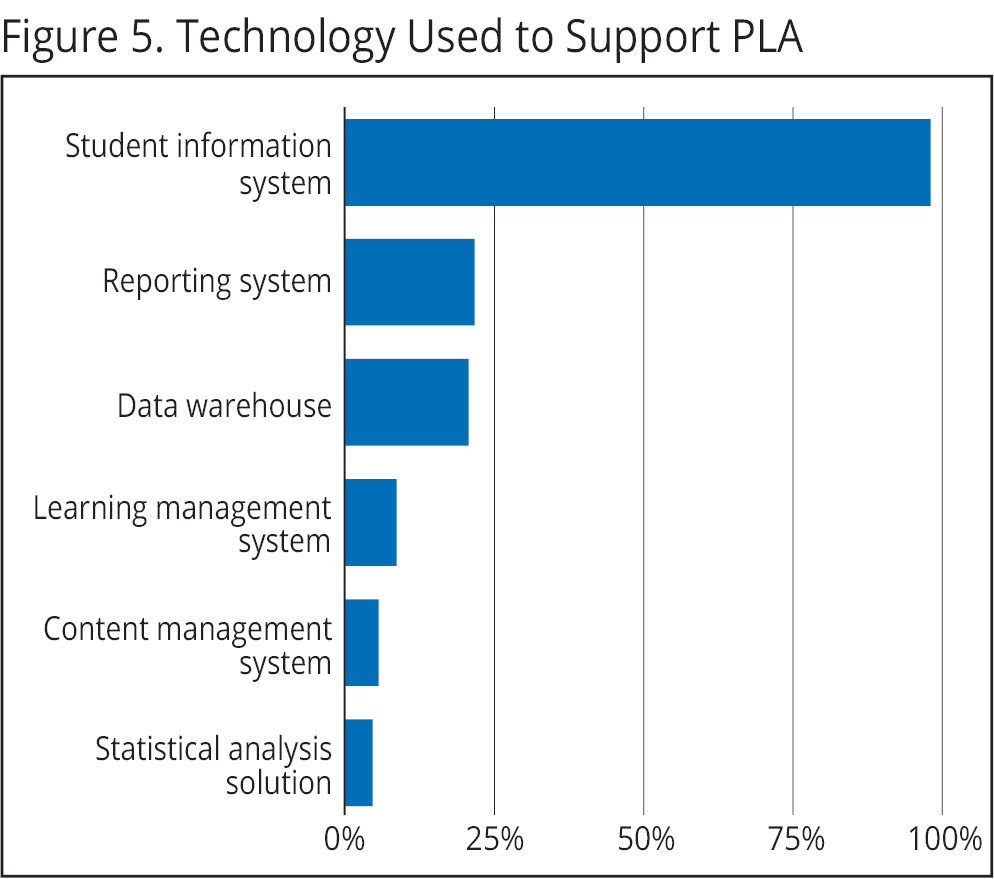
When asked about the number of full-time-equivalent employees (FTE) who support PLA, respondents were given the parameters that this was not meant to capture just those individuals who support PLA full time but any faculty, staff, or administrator who supports PLA over the course of a year. With this context in mind, nearly one-third of respondents report less than one FTE for PLA, and one-third have between two and four FTE (see Figure 6). Those who selected “more than 10 FTE” were prompted to indicate the number of employees; the 16 respondents indicated a range from 11 to 500 employees.
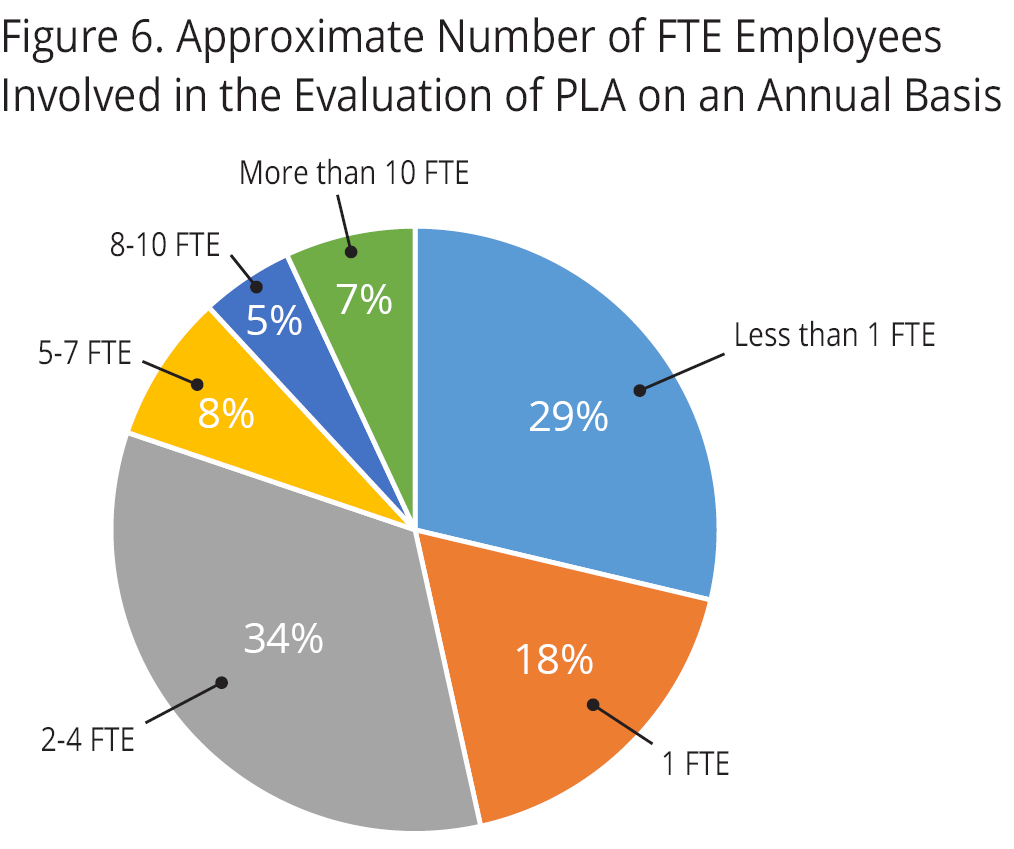
Two-thirds of respondents agree that the number of FTE assigned to support PLA at their institution is sufficient to support the volume of PLA requests from students. Most also agree that staff associated with PLA are sufficiently trained for their functions. Among those who find that staffing is insufficient, some would like more staff to speed up processing and expand offerings, with the intent of increasing the number of students who take advantage of PLA.
Use of Data and Reporting Practices
In the aggregate, just 32 percent of respondents reported tracking any data related to PLA over time. Public institutions are statistically most likely to do so and private not-for-profits are statistically less likely to track data related to PLA.[11] Institution size is also statistically related to whether or not data are used to track PLA over time; institutions with under 1,000 students are less likely to do so and institutions with 10,000+ or more students are more likely to track PLA data.[12] Among those that collect data, more than half report an increase in the recognition of prior learning, 5 percent report a decrease, and 45 percent report no change.
Institutions Without PLA Practice and Policy
PLA is not available to students at 21 percent of the 458 institutions that participated in this survey. Among non-PLA participating institutions, 20 percent reported that their institution has engaged in PLA at some point in the past but has ended the practice. Although the sample size is small, nearly one-half of these respondents reported that they are considering re-engaging in PLA again. Among those that have never used PLA, only 11 percent are considering it. Among these, PLA options under consideration from most to least interested include the evaluation of non-college education and training, individual assessments, standardized exams, faculty-developed exams, and conversion of institutional noncredit to credit. Reasons provided for not using PLA include lacking an institutional culture to do so, perceptions of a lack of rigor, and a lack of interest expressed by students.
Institutions with one or more of these characteristics are statistically less likely to offer PLA options to students: small, identified as rural-distant by IPEDS locale, private not-for-profit, or admitting 49 percent or fewer applicants.[13] However, the effect size associated with the differences is small.
Institutional Barriers to PLA and Perspectives on Equitable Access
Institutions that have both policies and practices in place to accept PLA were asked about which students are least and best served, the conditions needed to expand PLA, and current institutional barriers in the application of PLA. The collective responses have been distilled below in an effort to bring particular attention to issues of equity and access.
Some of the survey questions focused on institutional policies and practices that make it more difficult for some students to have their prior learning experience recognized. The descriptions of the problematic policies and practices have been grouped into the following categories:
- The amount of work required of a student to get their prior experiences evaluated
- Limits on course applicability
- Limits on both AP and IB applicability specifically
- Lack of faculty buy-in of the value and academic rigor equivalency associated with PLA
- Lack of student awareness and difficulty in explaining it to them
- Lack of a clear PLA policy and practice at the institution
- Institutional inexperience in awarding PLA
- Lack of manpower at the institution to complete the PLA
In addition, most institutions report that their policies limit the credits that can be earned through PLA in one or more of the following ways:
- Setting a maximum number of semester credit hours that can be earned by PLA
- Setting a maximum percentage of semester credit hours that can be applied towards a credential
- Limiting what the credit can be used for within the education credential completion requirements (see Figure 3)
- Not accepting PLA credits in transfer (evaluated by another institution) or limiting the acceptance of those credits to specific conditions
Roughly one-quarter of institutions do not have a policy that sets the maximum credit hour limit that can be earned through PLA, and 13 percent of institutions set both a maximum percentage and a maximum number of credit hours (see Figure 7). Of the remaining, 44 percent only set a maximum number of credits which can be earned by PLA, and 17 percent set a maximum percentage of credits towards a degree requirement.
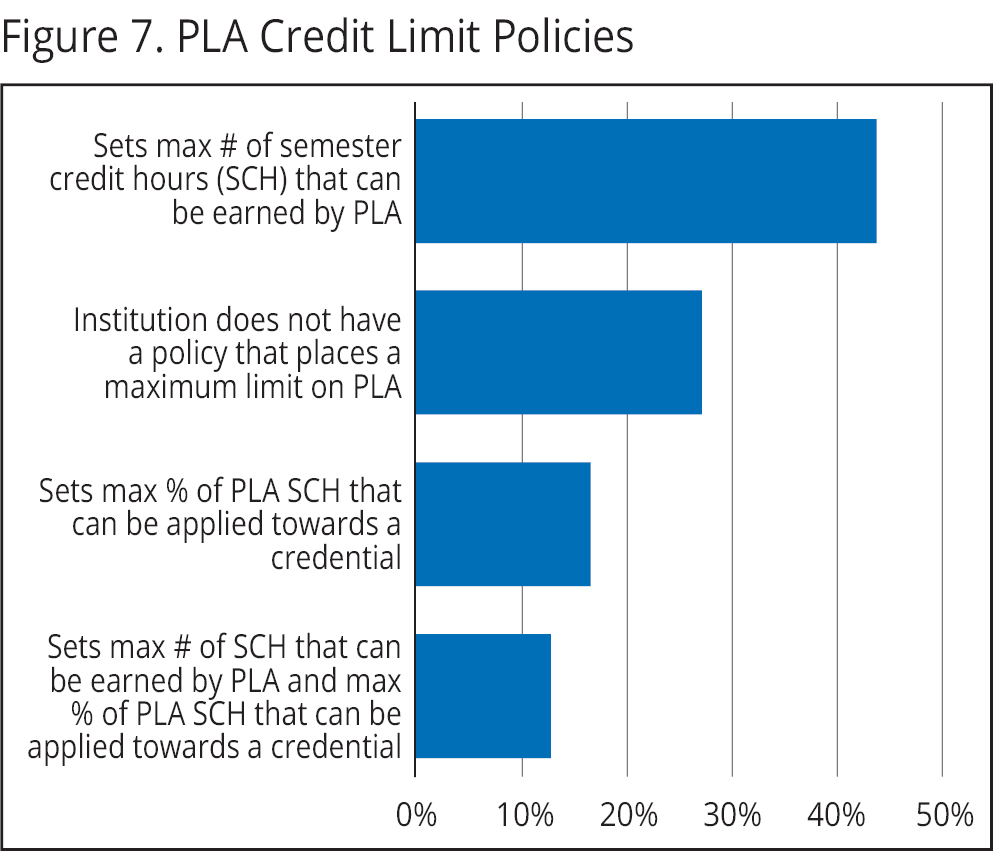
The maximum number of credit hours that can be earned through PLA varies considerably, with no practice trend (e.g., a semester-based number of credit hours) visible in the data (see Figure 8). Twenty respondents provided a semester credit hour limit related to the answer choice “other maximum number,” with the limit values ranging from 12 to 68 semester credit hours. Among those institutions that set a maximum percentage of degree requirement which can be earned by PLA, more than half set the limit between 25 percent and 74 percent of the degree (see Figure 9).[14]
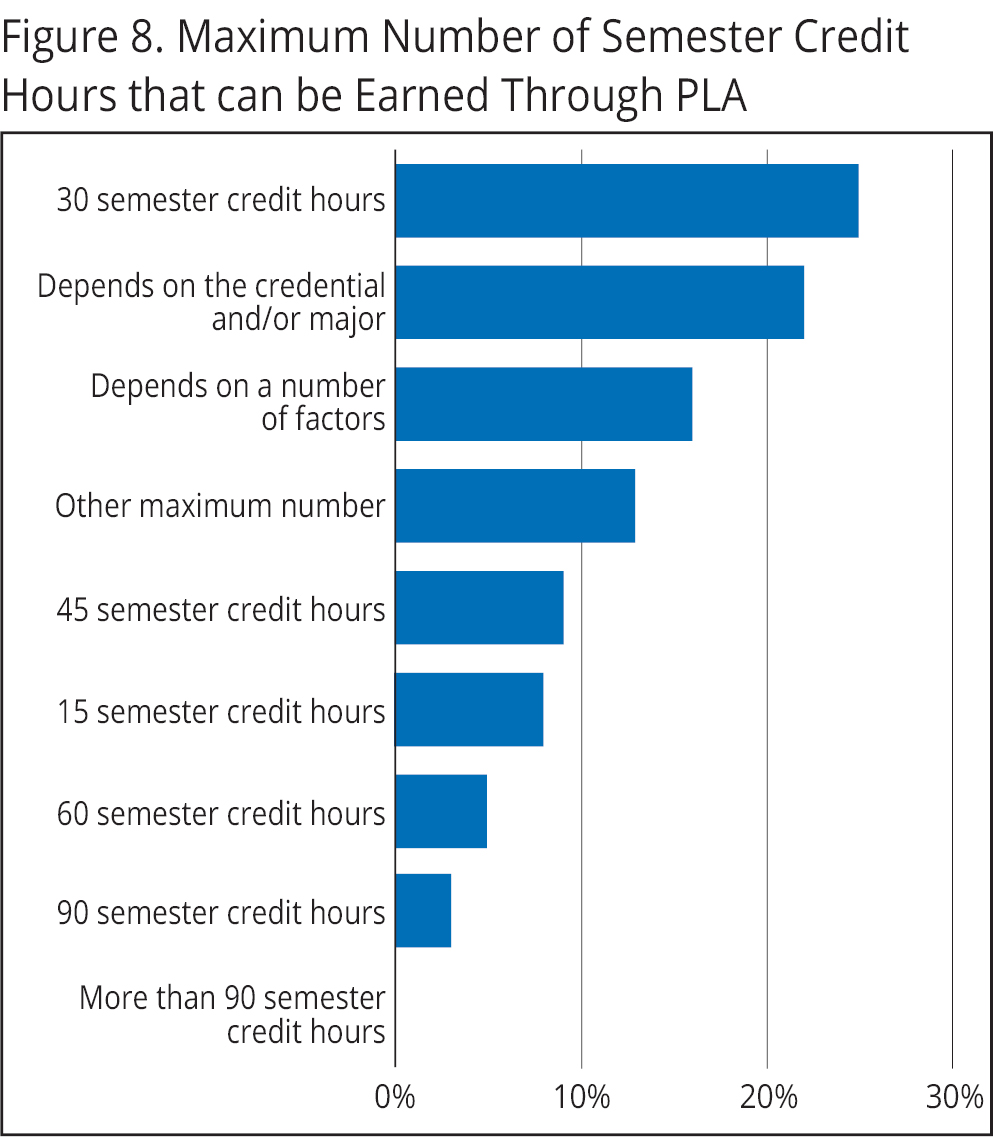
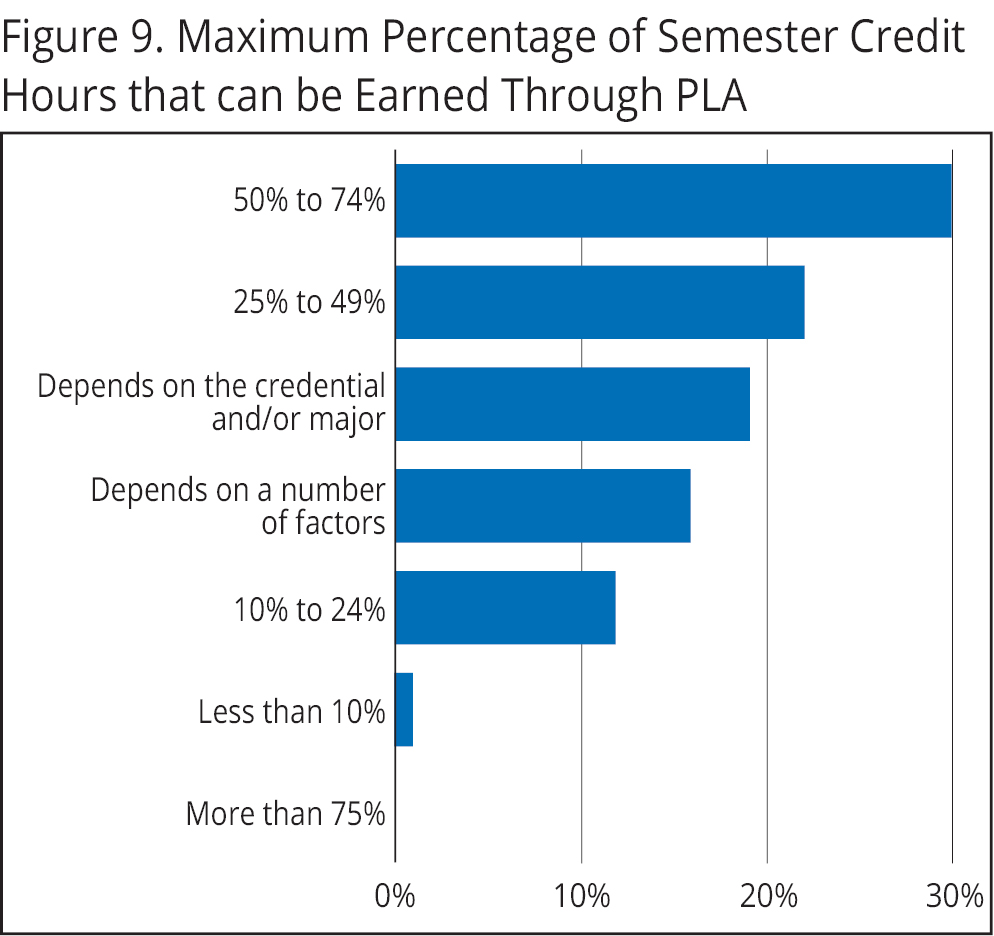
Additional policy factors that impact the maximum number of PLA semester credit hours include the source, type, credential level, transfer credit limits, and course level of the credit (e.g., lower-division, upper-division). Among the institutions that limit PLA semester credit hours by credential and/or major, most indicate that the limit applies to all majors and credential levels. Some institutions differentiate and set limits within the institution by any, all, or some combination of the following: departmental preferences, credential level (i.e., certificate, associate, bachelor’s), and major type (e.g., public safety, criminal justice).
Some institutions reported that state regulations, transfer limit policy, and residency credit hour requirement policies also shape the maximum percentage of semester credit hours that could be earned through PLA at their institutions.
Nearly two-thirds (65 percent) of institutions will not recognize another institution’s evaluation of PLA in transfer, 8 percent will do so, and 26 percent will do so only under certain conditions. Lower-division-only institutions are statistically more likely to accept PLA in transfer than undergraduate-only or undergraduate comprehensive institutions. Private institutions are also less likely than public institutions to accept PLA in transfer. Figure 10 details the conditions that must be met for those institutions that conditionally accept PLA in transfer; Appendix C contains the other conditions provided by respondents.
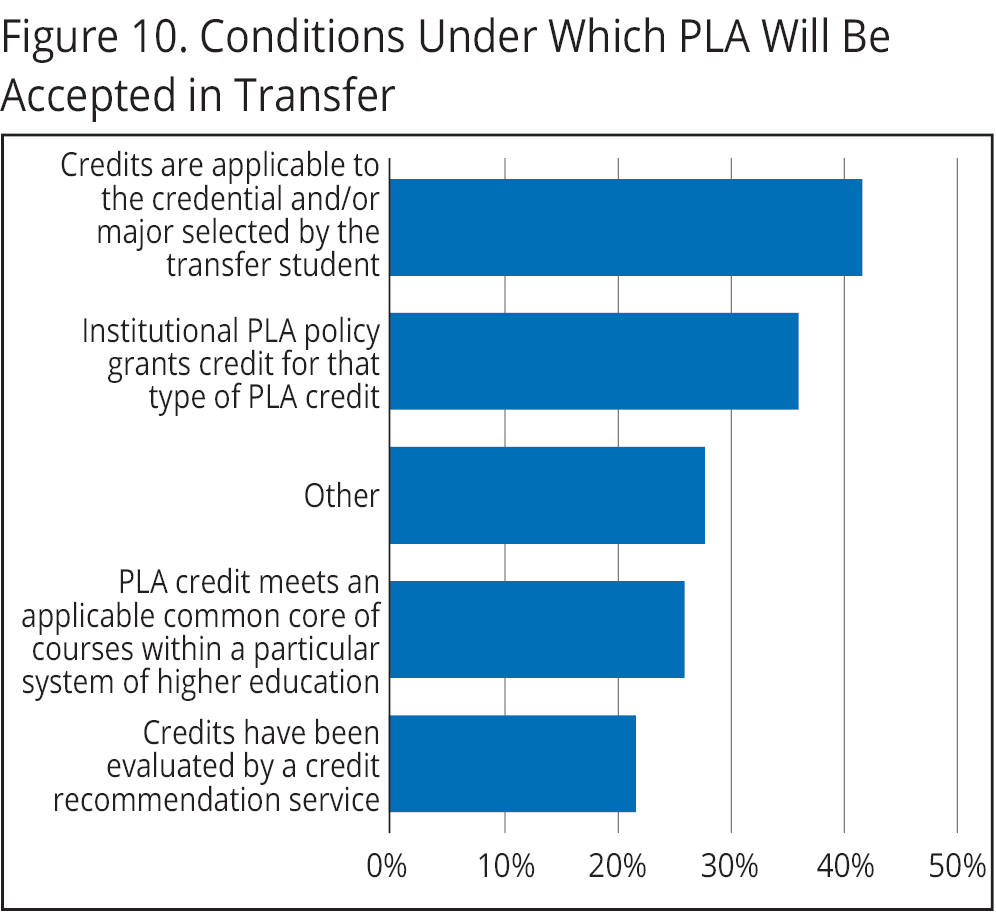
Adding to the policy limits described above, essentially half (48 percent) of the institutions’ PLA policies do not have a provision for a student to appeal the PLA evaluation decision. All of the limitations in the acceptability and/or applicability of PLA included above may have a negative impact on time to degree and cost of degree. Further research is needed to determine the extent of either of these possible negative consequences of current PLA practice.
Respondents were asked what they perceived as the characteristics and circumstances of students most likely to be able to take advantage of PLA. Several common characteristics and circumstances were listed: “academically prepared,” “adult students,” “active military,” “middle to upper socioeconomic status,” “recent high school graduates with AP and IB coursework,” “returning adult students,” and “veterans.”
About one-third of those respondents at institutions that have PLA agreed that there are institutional policies and/or practices that make it more difficult for some students to have their prior learning recognized. Over 20 percent of the respondents agreed that institutional fees associated with PLA are a barrier for some students. This group of respondents indicated that minority, economically disadvantaged students, and/or Pell recipients are more likely to be negatively impacted by fees.
The percentage of institutions that have access to student-level PLA data for analysis is small. Only 34 respondents answered the question about whether PLA data are tracked in a way to support student demographic level reporting; of these, 56 percent responded that they do. Even fewer answered detailed questions about how well different student populations are served. Given that this sample is small, the opinion data included in Table 9 are viewed as anecdotal and, as such, conclusions about service to different student populations cannot be garnered. With those caveats in mind, the few that collect and examine data at this level believe that no student group is underserved by PLA.
In addition, among those who have sufficient access to student level data configured in a manner that enables them to draw conclusions, several noted that students who are able to take advantage of PLA are more likely to complete their degree than other students, while others remarked there was no impact on completion among PLA recipients.
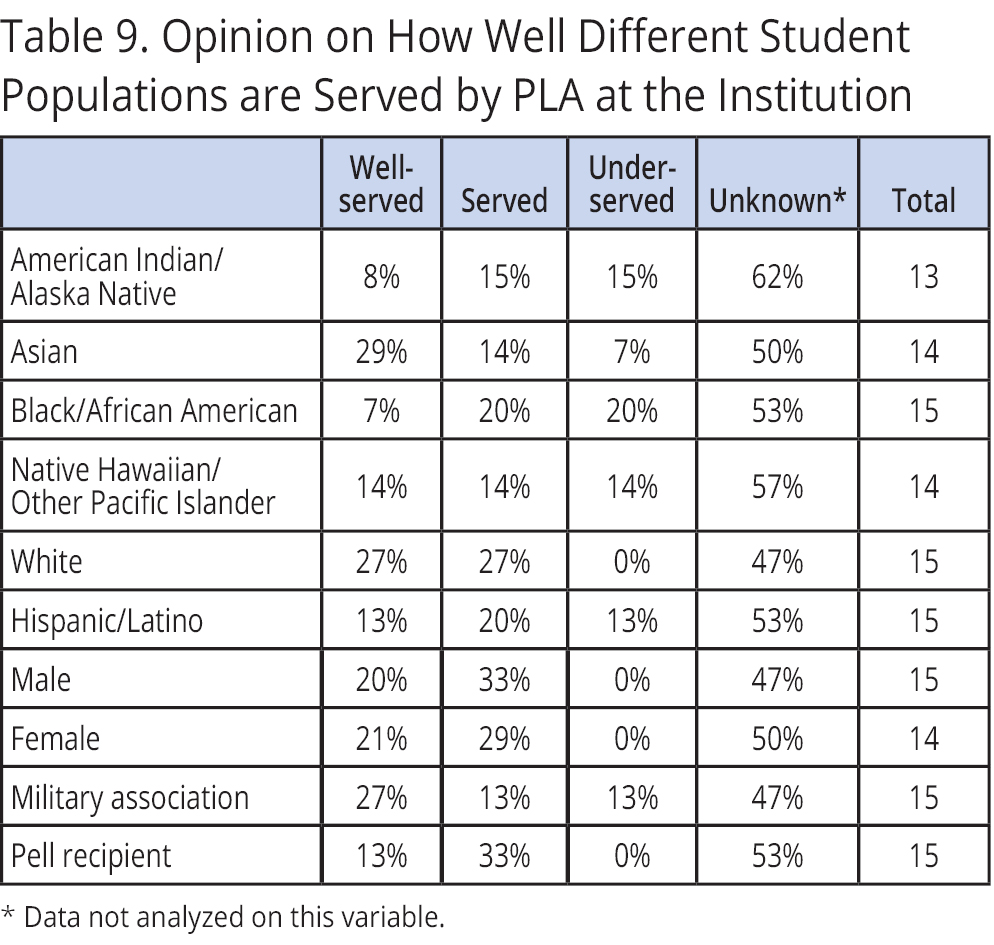
Student Experiences with and Perceptions of PLA
After gaining an understanding of institutional practice with PLA, we wanted to learn from students about their experiences with PLA. This survey was deployed to a national sample of current college students.
Student Survey Sample
1,184 current college students responded to the survey. Gender representation mirrors that of higher education enrollment in the United States: 55 percent were female, 43 percent were male, and 1.6 percent preferred not to self-identify. Fifty-five percent of the respondents were under 25 years old, 32 percent were between 25 and 34 years old, and 13 percent were 35 years old or older. Only 17 percent identified as Hispanic or Latino, 71 percent identified as White, 18 percent identified as Black, 8 percent identified as Asian, 5 percent identified as American Indian/Alaska Native, and less than 1 percent identified as Native Hawaiian or Other Pacific Islander (students were encouraged to check all the ethnicities with which they identify).
Key Findings
- A quarter who earned PLA credit indicated that PLA credit “made it possible for them to complete a degree/program they otherwise would not have.”
- Two-thirds of students selected “shortening the time to their degree” as a benefit to earning credit for prior learning.
- Half of students indicated that this opportunity has reduced the cost of their degree.
- Most students are aware that they can seek academic credit for college-level learning acquired through work or life experiences outside of the classroom but about a third chose not to pursue it.
- At the time of this survey, 60 percent of students had completed their attempts to earn credit through PLA; of these, 90 percent were successful in earning credits.
- Individual connections appear to be the most important factor in how students learn about the opportunity to earn credit.
Most students (62 percent) were enrolled in a four-year institution at the time they completed the survey, while 32 percent were enrolled in a two-year institution. Two-thirds of the respondents that were enrolled at four-year institutions were under the age of 25, while almost two-thirds of the students that were enrolled in a two-year institution were 25 years or older. There was no difference in the gender, race, or ethnicity of students across four- or two-year institutions. Almost half (43 percent) of all the students surveyed have attended more than one institution.
Students identified the type of non-classroom college-credit-eligible experiences they have had (see Figure 11). Half have completed an AP or IB course. Half also have work experience after high school, and 37 percent have volunteer experience after high school. Just over 25 percent of students surveyed have completed a course or program from a non-college provider (such as Microsoft) or a professional certificate or license through a non-college provider. Only 6 percent indicated that they currently or previously have served in the military. Students enrolled in a four-year institution are more likely to indicate participation in AP and/or IB courses, while students enrolled in a two-year institution are more likely to indicate work and military experience.
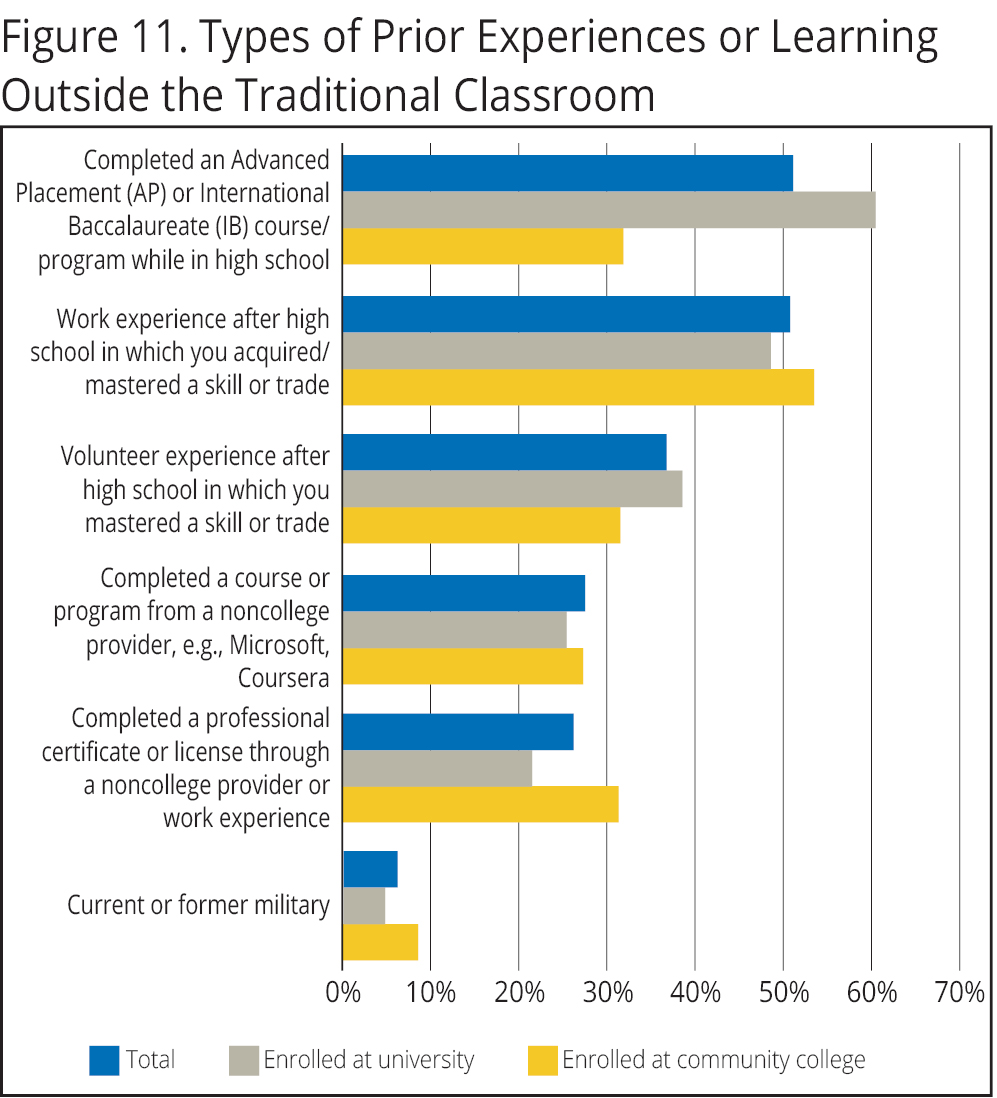
Seventy-eight percent of all students (and 70 percent of students without AP and/or IB experience) surveyed are aware of the possibility of earning college credit for some or all of the experiences they selected.[15] Regardless of the institution they attended, Asian students are more likely to know about the opportunity to earn credit for prior learning, while American Indian students are the least likely. When asked how they knew about the opportunity to earn credit for their prior learning and/or experiences, students indicated that individual connections are the primary means of learning about PLA (see Figure 12). High school college counselors, academic advisors on the college campus, other students, and family members were the four most commonly cited sources of knowledge. Older students and students attending a two-year institution primarily learned about PLA from their employer, a coworker, and someone in the military at slightly higher rates than their peers who were younger and who were attending four-year institutions.
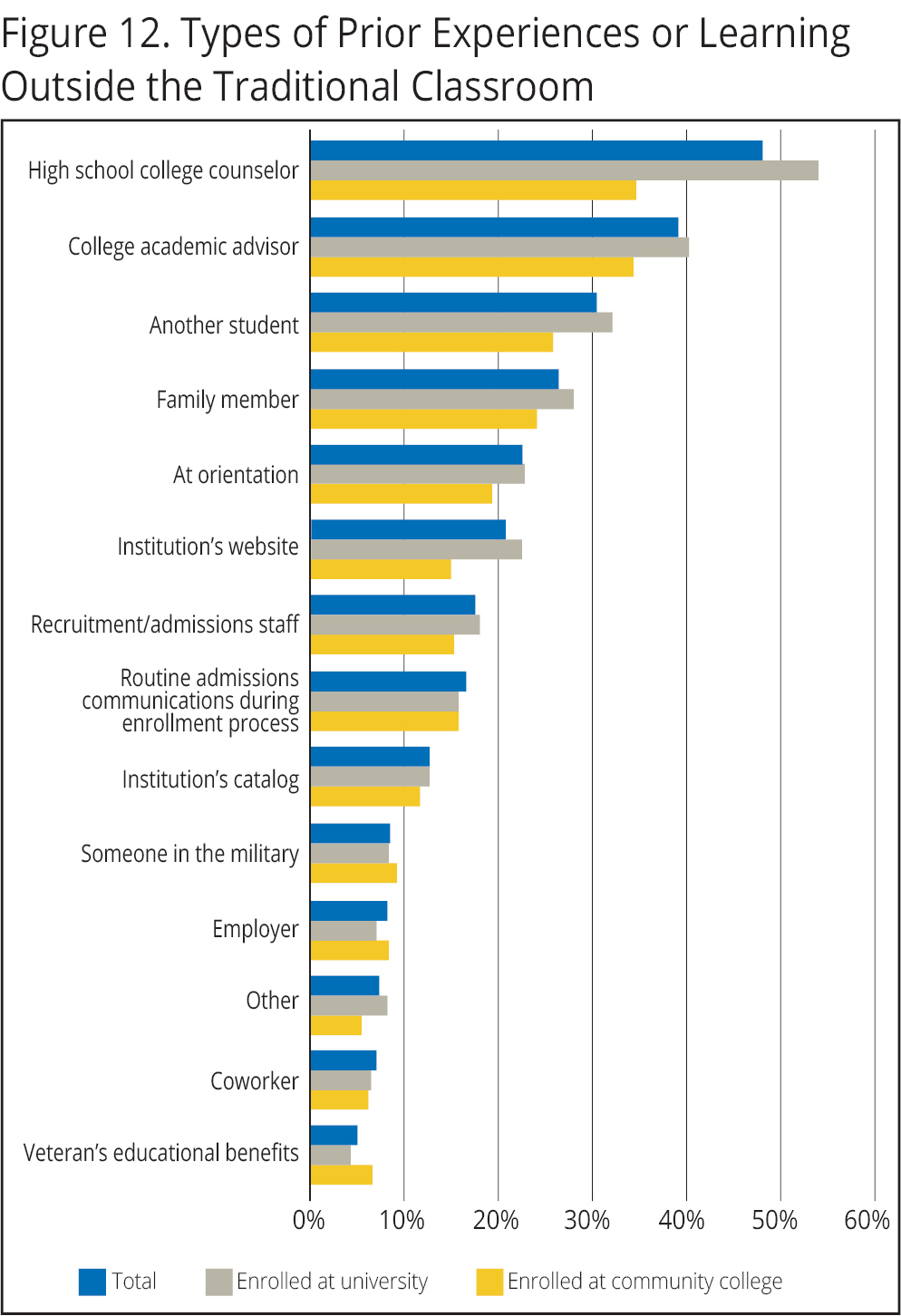
Of the students who were aware they could earn credit for learning acquired through life/work experiences, 60 percent had attempted to get credit and another 12 percent were in the process of attempting to earn PLA credit at the time of this survey. Of those that attempted to earn credit, 90 percent received credit. A quarter who earned PLA credit indicated that PLA credit “made it possible for them to complete a degree/program they otherwise would not have.” [16]
“I want all the credit I can get without paying a ton of money.”
Asian students were more likely to attempt to earn credit, while American Indian and Native Hawaiian/Other Pacific Islander students were less likely. A similar pattern was found among the students who were successful in earning credit for their prior learning. There were no distinct differences from the sample averages for other populations of students (i.e. Black, White, and Hispanic/Latino). This finding holds true even when students with AP and/or IB experience are filtered out of the sample.
Students selected from the responses proffered the ways in which earning credit for their prior learning and experiences helped them in school and in their career (see Figure 13). Students could select as many options as applied to them. The most popular responses were related to educational benefits: two-thirds of the students who earned credit indicated that the benefits were related to shortening the time it took to reach their educational goal, one-half of the students indicated this credit reduced the cost of their educational pursuits, and 25 percent suggested that earning this credit made it possible for them to complete a degree/program they otherwise would not have completed. More than 16 percent of the students indicated that earning this credit benefited them in their career (such as getting a job or getting a promotion in their current jobs). Students from four-year institutions indicated that this credit benefited them in their college career more so than their two-year institution peers, while students at two-year institutions indicated this credit benefited them in their careers more so than their four-year peers.
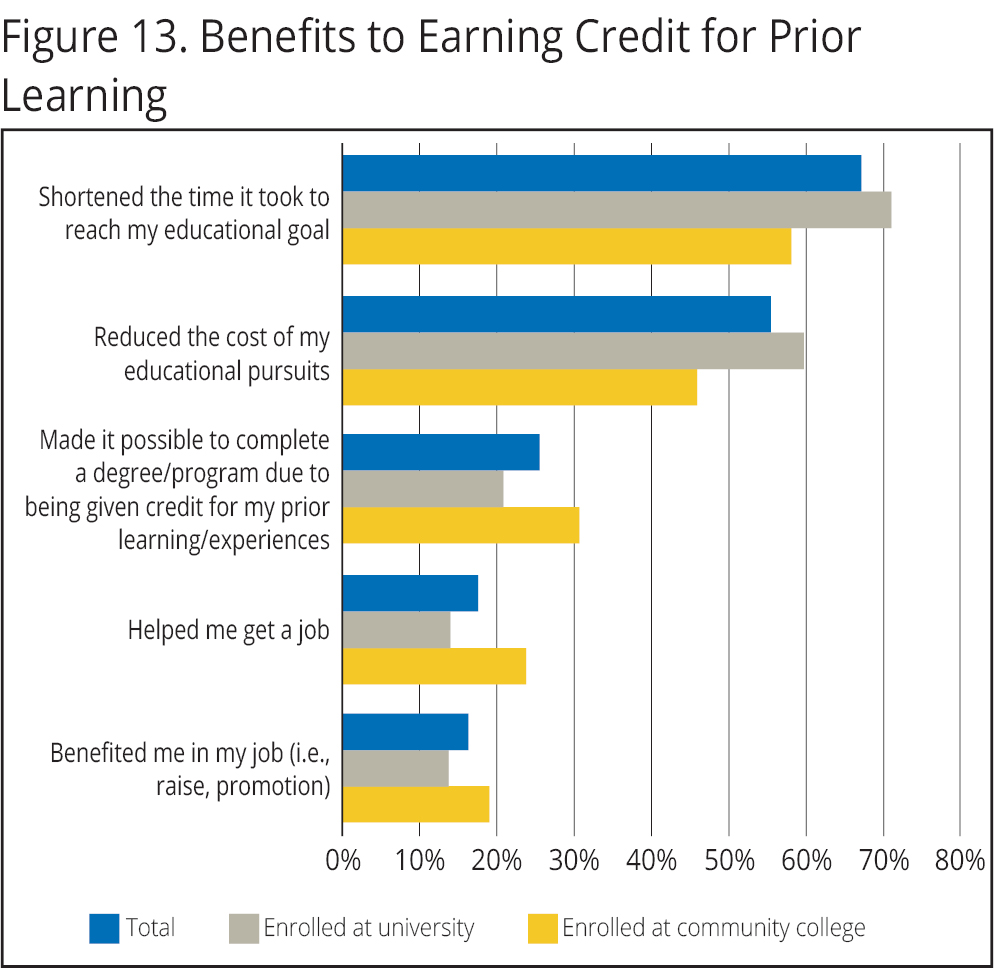
Roughly one-third of the students responded that while they knew there was the possibility of earning credit for their learning acquired through life/work experiences and learning outside of the classroom, they chose not to attempt to earn credit for prior learning (see Figure 14). Students selected the reasons why they chose not to pursue credit, and the top four reasons are: lack of information (26 percent), the money required (21 percent), the time required (21 percent), and credit limitations (17 percent) (i.e. the number of credits, where credits could be applied, etc.).
“I [would have liked] more information about the process and what is required. I just am fearful of going through a process to be told it doesn’t apply [to my degree]”.
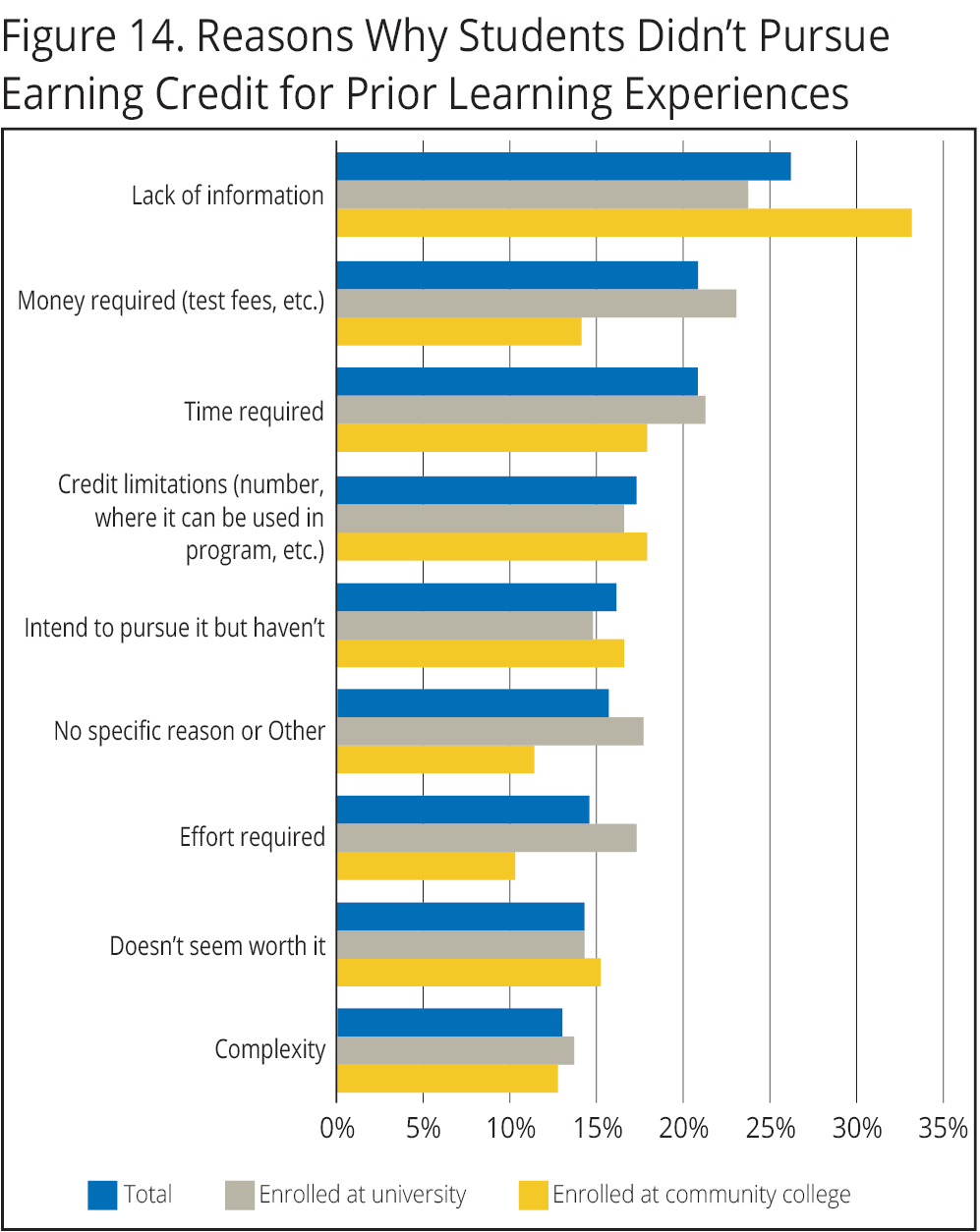
Students’ experiences with PLA at their campuses demonstrate that there are many pathways for earning credit for extra-institutional learning, and that most who try are successful in doing so. The benefits they note—saving money and time—also mirror the benefits that institutions note about PLA. Just as a minority of institutions indicated there are some barriers to PLA on their campuses, including making students aware of the option, a small percentage of students shared they were not aware of the ability to earn credit for their non-classroom experiences.[17] Almost all who indicated they were not aware of the opportunity agreed that if they had known about the opportunity to earn credit, they would have wanted to try (there was no difference in response among four-year or two-year students).
“I already have one type of certification; it would be nice to apply that toward future schooling instead of having to take additional classes.”
Closing
This research provides insights related to undergraduate prior learning assessment at U.S. degree-granting institutions including:
- the pervasiveness of PLA at undergraduate serving institutions
- current academic records policy and practice for PLA
- perceived or quantifiable issues of equity with the application and availability of PLA to student populations served
- perceived or quantifiable issues of scalability around PLA
- how, or if, data are used to understand how the application of PLA impacts student success.
In addition, we heard from students about their experiences and perceptions with PLA. More specifically, we heard:
- about the extent to which students have college-level learning acquired through work or life experiences in areas that could be awarded academic credit
- how they learn about the possibility of earning credit through PLA
- if they have attempted to earn credit in this way, and if so, how successful they have been.
From the data, we can conclude regarding institutional practices that:
- one or more types of PLA are available at most institutions and apply to credentials from non-credit programs to a bachelor’s degree, depending on the institution
- credits earned in this manner are generally applicable to a wide variety of credential requirements
- there is an absence of both longitudinal PLA data and student-level PLA data at most institutions
- the absence of institutional data contributes to a lack of understanding of the impact PLA has across student cohort groups and to student success/degree completion
- there is room to improve institutional policies and practices to enable more students to be aware of and to take advantage of PLA at their institution
- anecdotal data and personal perceptions among respondents suggest that students with certain characteristics are more readily able to take advantage of PLA than others. These include current active military, academically gifted high school students, adult students, students from advantaged economic backgrounds, and returning students.
Overall, students are generally aware of and pleased with their experiences earning credit for their college-level learning acquired through work or life experiences.
Recommendations
As stated at the beginning of this report, the effective application and understanding of PLA is one of AACRAO’s stated core professional proficiencies for academic records professionals. In general, the institutions who shared their PLA practices with us have a number of policies and practices in place that support PLA in a positive manner and in alignment with AACRAO’s recommendations. We advocate that institutions offer opportunities for students to earn credit for college-level learning acquired through work or life experiences, including implementing multiple ways to evaluate PLA for course equivalency.
The practice of differentiating PLA credit on the transcript often has negative implications for students who transfer from your institution to another: 65 percent of institutions do not accept PLA in transfer. Ideally, credit awarded for any type of PLA should not be differentiated from institutional credit on a student’s transcript since it is your institution that is completing the evaluation of the student learning outcome/course equivalency just as faculty would in a standard class.
As of 2020, two of seven accreditors still place some limits on how PLA can be used internally.[18] We believe this to be an outdated practice because, for example, there are currently no limits on how credits earned by direct assessment can be applied to a degree and direct assessment evaluation methods are similar, if not identical, to the evaluation methods use to evaluate PLA. We further advocate that institutions who are impacted by accrediting constraints on the use of PLA attempt to get the constraints removed.
Over one-third of institutions reported increasing the options for PLA on their campuses in the last three years. We recommend that institutions considering adding PLA to their institution or increasing their PLA options be prepared to address one or more of the following challenges in advance of proposing changes. These include:
- Securing buy-in from academic leaders and faculty to the value of PLA for the student
- Securing buy-in from academic leaders and faculty to the academic equivalent between credits earned through traditional courses and those awarded through PLA
- Updating or establishing institutional policy to support PLA
- Ensuring that PLA policy has a provision for a student to appeal the PLA evaluation decision
- Identifying and implementing viable information pathways to get PLA information to students
- Building internal awareness of PLA options across the institution
- Dedicating additional staff resources to supporting PLA
Suggestions for how to address the challenges above include:
- Using data to show the impacts on PLA on students and for institutions completion and enrollment goals can serve as means to gain buy-in for increasing or adding PLA options. This report and other resources available through WICHE, CAEL, and others will help frame that perspective.
- Tying PLA assessment methods to the same student learning outcomes as those associated with standard courses to establish academic equivalence between PLA credit and standard course credit.
- Seeking policy and practice models from institutions who serve students well through PLA to modify or establish your own institutional PLA policies and practice.
We found that few institutions can track participation in PLA back to student demographics, which makes it difficult—if not impossible for some—to conduct any type of assessment of equity. Given that current student information systems are relational databases, tying academic records to the demographic details associated with each student, it is likely that this apparent lack of access to data is not because the data do not exist but rather that it, or the reporting functions, are not configured in such a way as to support examining PLA data through the lens of student characteristics. It is recommended that demographic data be tied to the PLA credit record data in such a way as to support assessments of equity. In addition, if after an examination of the data there appears to be issues of inequity, it is recommended that PLA policies and/or practices be reviewed and revised to help address the issue.
Postsecondary student information systems contain similar academic record functionality and fields and as such are likely to be able to be configured/used in such a way that tracking PLA credit at the student level is possible. For example, the recording of PLA is very similar to other types of credit awarded and transcripted such as credit by examination, AP credit, transfer credit, etc. Institutions could modify these practices to serve to identify the unique type of credit being awarded.
Seeking out institutions that track student data at the demographic level is one of the easier ways to find a solution that might work for your institution. However, these institutions are few and far between. The sidebar shows an example of how an institution might configure its PLA records to support student level data depending on its particular student information system.
How to configure an institution’s PLA records to support student-level data collection
Ideally, the PLA “tag” should reside at the individual course registration number level so the PLA history is tied to the student record and can be tracked but in a way that is not generally identifiable on a student’s official academic transcript per the recommendation above. For the purposes of this discussion the SIS data fields are defined as follows:
DEFINITIONS:
- Course – resides at the catalog level in the SIS (e.g., ENG 101)
- Subject code – commonly a three- or four-letter code used to identify the subject (e.g., ENG for English, BIOL for biology)
- Course number – the number associated with the academic level of the course (e.g., 101, 301, 501 etc.)
- Section number – a field often available in the SIS but often not visible to the student or recorded on a transcript and not always used.
- CRN – course registration number. The unique number assigned to the course in the registration system, and which is also tied to a student’s academic registration history.
STEPS:
- Identify specific section numbers to indicate PLA credit courses and build the CRN shells as needed by term and/or roll-over often awarded courses from one term to another
- Create an open-course CRN like you would for a Massive Open Online Course (MOOC) or other open-entry/open-exit courses and add students to that CRN as you award PLA credit. Add a unique section number or CRN level notes to identify it as only for PLA credit
- If PLA credit is posted to the academic record in a manner similar to transfer credit, create a transfer institution code unique to PLA
- Create an instructional method code tied specifically to PLA as long as that code it not visible on an official transcript
Endnotes
[1] American Association of Collegiate Registrars and Admissions Officers, “Evaluating Prior Learning,” accessed on 22 June 2020 at https://www.aacrao.org/resources/core-competencies/professional-proficiences/transfer-articulation/evaluating-prior-learning.
[2] It is important to note that while this study includes AP/IB in the definition of standardized exams as a method of PLA, AP/IB is not available as a form of PLA for returning adult students to use for their postsecondary life and work experiences.
[3] In all instances of the survey, CAEL content was used to help shape the content of the survey. The 2014 iteration focused on PLA options associated with adult learners and as such, AP credit and IB credit were excluded from the question set because they represent pre-college credit typically earned by high school students. Wendy Kilgore, Credit for Prior Learning Practices: Results of the AACRAO December 2014 60 Second Survey (Washington D.C.: American Association of Collegiate Registrars and Admissions Officers, 2014), accessed on 22 June 2020 at https://www.aacrao.org/docs/default-source/research-docs/aacrao_dec_2014_60_second_survey_credit_for_prior_learning_practices.pdf.
[4] Wendy Kilgore, 2015 U.S. Higher Education Transcript Practices and Best Practice Opinions (Washington D.C.: American Association of Collegiate Registrars and Admissions Officers, 2015), accessed on 22 June 2020 at https://www.aacrao.org/docs/default-source/research-docs/2015-u-s-higher-education-transcript-practices-and-best-practice-opinions—june-201582c7f86f39a34dd9930c84745383b506.pdf?Status=Temp&sfvrsn=c2ab0a3b_4.
[5] Wendy Kilgore, Transfer Credit Policy: May 60-Second Survey 2017 (Washington D.C.: American Association of Collegiate Registrars and Admissions Officers, 2017), accessed on 22 June 2020 at https://www.aacrao.org/research-publications/research/registration-records-reports/transfer-credit-policy—may-60-second-survey-2017.
[6] When the question and question sample size supported doing so, the data were examined for statistically significant differences in practices based on institutional characteristics including size, type, control, minority-serving institution status, locale, and selectivity as measured by the percentage of students admitted. If statistically significant differences were found, they are noted in the narrative. This report contains a summary-level synthesis of the survey data and provides conclusions on equity and scalability related to PLA.
[7] Identified as rural-distant by IPEDS: Rural – Distant (42): Census-defined rural territory that is more than 5 miles but less than or equal to 25 miles from an Urbanized Area, as well as rural territory that is more than 2.5 miles but less than or equal to 10 miles from an Urban Cluster (https://nces.ed.gov/programs/edge/docs/NCES_LOCALE_USERSMANUAL_2016012.pdf).
[8] Effect size = Cramer’s V unless otherwise stated.
[9] Effect size: medium and small respectively
[10] At the time of publication, AACRAO is not aware of any institutional reporting on the effectiveness of these methods as they relate to different student groups; this is a place where further research is needed.
[11] Effect size: medium
[12] Effect size: large
[13] In the context of this report, the term “statistically” means there is a statistically significant difference from the mean as measured by a chi-square test unless otherwise stated. If the term statistically is not used to describe a difference, then the value is different descriptively but not statistically.
[14] At the time of publication, AACRAO is not aware of a relationship between PLA policies and transfer acceptance policies at institutions; this is a place where further research is needed.
[15] 81 percent of four-year institution students and 73 percent of two-year institution students. We acknowledge that AP/IB is a form of PLA that is not often available for returning adult students, so we filtered out students with AP/IB experience and even then 70 percent of students reported knowing about the opportunity to earn PLA.
[16] Questions remain regarding what about earning the credit made it possible for students to earn their degree, was it credit to cover a particular type of requirement that was a barrier? This is a place were further research could be beneficial.
[17] For more detailed results from the student survey on PLA, please see “PLA from the Student’s Perspective: Lessons Learned from Survey and Interview Data” a brief written by the Western Interstate Commission for Higher Education regarding student perspectives related to access to and uptake of prior learning assessment. WICHE disaggregates the data from this student survey by race/ethnicity, age, and gender, as well as by sector
[18] In the report written by Council for Adult and Experiential Learning, Holding Tight or At Arm’s Length: How Higher Education Regional Accrediting Bodies Address PLA (Indianapolis, IN: Council for Adult and Experiential Learning, 2014), 7, accessed on 20 June 2020 at http://cdn2.hubspot.net/hubfs/617695/premium_content_resources/pla/PDF/CAEL_PLA_Accreditation.pdf, three of seven accreditors placed limitations on the ways in which PLA credits can be treated internally. In 2020, one of the three, Northwest Commission on Colleges and Universities, revised its policy on credit for prior learning. The new policy does away with the 25% threshold “in favor of higher education institutional best practices around credit for prior learning”, Northwest Commission on Colleges and Universities, 2020 Standards for Accreditation and Eligibility Requirements Revision June 2019 Update (Redmond, WA: Northwest Commission on Colleges and Universities, 2019), 22, accessed on 8 July 2020 at https://www.nwccu.org/wp-content/uploads/2019/06/NWCCUStandardsJuneUpdateFINAL2.pdf.
References
American Association of Collegiate Registrars and Admissions Officers. “Evaluating Prior Learning.” Accessed on 22 June 2020 at https://www.aacrao.org/resources/core-competencies/professional-proficiences/transfer-articulation/evaluating-prior-learning.
Council for Adult and Experiential Learning. Holding Tight or At Arm’s Length: How Higher Education Regional Accrediting Bodies Address PLA. Indianapolis, IN: Council for Adult and Experiential Learning, 2014, 7. Accessed on 20 June 2020 at http://cdn2.hubspot.net/hubfs/617695/premium_content_resources/pla/PDF/CAEL_PLA_Accreditation.pdf.Council for Adult and Experiential Learning and Western Interstate Commission for Higher Education. Boost from PLA: Results from a Targeted Study of Adult Student Outcomes. Boulder, CO: Western Interstate Commission for Higher Education, forthcoming.
Kilgore, Wendy. Credit for Prior Learning Practices: Results of the AACRAO December 2014 60 Second Survey. Washington D.C.: American Association of Collegiate Registrars and Admissions Officers, 2014. Accessed on 22 June 2020 at https://www.aacrao.org/docs/default-source/research-docs/aacrao_dec_2014_60_second_survey_credit_for_prior_learning_practices.pdf.
Kilgore, Wendy. 2015 U.S. Higher Education Transcript Practices and Best Practice Opinions. Washington D.C.: American Association of Collegiate Registrars and Admissions Officers, 2015. Accessed on 22 June 2020 at https://www.aacrao.org/docs/default-source/research-docs/2015-u-s-higher-education-transcript-practices-and-best-practice-opinions—june-201582c7f86f39a34dd9930c84745383b506.pdf?Status=Temp&sfvrsn=c2ab0a3b_4.
Kilgore, Wendy. Transfer Credit Policy: May 60-Second Survey 2017. Washington D.C.: American Association of Collegiate Registrars and Admissions Officers, 2017. Accessed on 22 June 2020 at https://www.aacrao.org/research-publications/research/registration-records-reports/transfer-credit-policy—may-60-second-survey-2017.
Klein-Collins, Rebecca. PLA Data Tracking. Indianapolis, IN: Council for Adult and Experiential Learning, 2015.
Northwest Commission on Colleges and Universities. 2020 Standards for Accreditation and Eligibility Requirements Revision June 2019 Update. Redmond, WA: Northwest Commission on Colleges and Universities, 2019, Accessed on 8 July 2020 at https://www.nwccu.org/wp-content/uploads/2019/06/NWCCUStandardsJuneUpdateFINAL2.pdf.
Valenzuela, Ireri, Donald MacIntyre, Becky Klein-Collins, and John Clerx. Prior Learning Assessment and Competency-Based Education: An Overview of Programs, Policies, and Practices. San Rafael, CA: Research and Planning Group for California Community Colleges, 2016.
About the Authors
- Wendy Kilgore, Ph.D., is the Director of Research for AACRAO with more than 20 years of experience as a higher education administrator and consultant in the United States and Canada. Prior to her full-time work with AACRAO, Kilgore served as State Dean of Enrollment Services for the Colorado Community College System and Director of Admissions and Registrar for the Pima County Community College District.
About the organizations
- American Association of Collegiate Registrars and Admissions Officers (AACRAO) is a non-profit, voluntary, professional association of more than 11,000 higher education professionals who represent approximately 2,600 institutions in more than 40 countries. Its mission is to provide professional development, guidelines, and voluntary standards to be used by higher education officials regarding the best practices in records management, admissions, enrollment management, administrative information technology, and student services. AACRAO represents institutions in every part of the higher education community, from large public institutions to small, private liberal arts colleges. The association promotes the well-being and advancement of professionals in the higher education community by engaging members in the collaborative pursuit of excellence in admissions, registration, and enrollment services.
- Lumina Foundation is an independent, private foundation in Indianapolis that is committed to making opportunities for learning beyond high school available to all. Lumina envisions a system that is easy to navigate, delivers fair results, and meets the nation’s need for talent through a broad range of credentials. Lumina’s goal is to prepare people for informed citizenship and for success in a global economy.
- Strada Education Network is a national nonprofit dedicated to improving lives by catalyzing more direct and promising pathways between education and employment. Strada engages partners across education, nonprofits, business, and government to focus relentlessly on students’ success throughout all phases of their working lives. With these partners they address critical college-to-career challenges through strategic philanthropy, research and insights, and mission-aligned affiliates, all focused on advancing the universal right to realized potential.
Copyright
Copyright © 2020 by the Western Interstate Commission for Higher Education
3035 Center Green Drive, Boulder, CO 80301-2204
An Affirmative Action/Equal Opportunity Employer
Printed in the United States of America
Publication number 4a500121
Disclaimer
This publication was prepared by Wendy Kilgore, director of research, American Association of Collegiate Registrars and Admissions Officers. The opinions expressed in this report are those of the author and do not necessarily represent those of Lumina Foundation, its officers, or its employees, nor do they represent those of Strada Education Network, its officers, or its employees.

